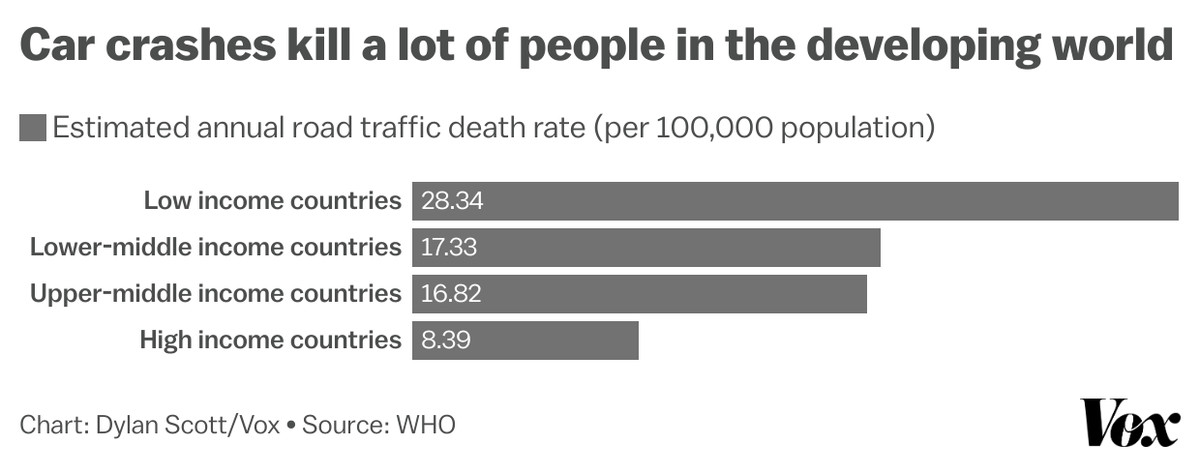February 12, 2024:
Kelvin Kiptum, who set a world-record marathon time this past October at the Chicago Marathon and was expected to contend for gold at this summer’s Olympic Games, died Sunday in a car crash in his home country of Kenya, after his car veered off the road and into a ditch. At just 24 years old, he had run three of the seven fastest marathons ever recorded, including his record 2:00:35 run in Chicago.
Because of Kiptum’s international celebrity, the tragedy drew headlines around the world. But his death reflects a broader epidemic of preventable car crash deaths in the Global South — a pattern that has intensified in recent years, even as car fatalities in affluent countries have been declining (the US is a notable exception).
Last year, the World Health Organization reported that traffic fatalities had increased by 17 percent in Africa over the past 10 years, even as they fell 5 percent overall worldwide. Road crashes are now one of the top causes of the deaths in a continent contending with plenty of other public health challenges.
The rise in traffic crashes may partly reflect Africa’s economic growth in recent years. “Part of the reason for increased fatalities in Africa is the increase in the number of vehicles on the roads,” Nhan Tran, who leads the WHO’s safety and mobility unit, told the Guardian in December. “People who were not able to afford a vehicle 10 or 20 years ago can now buy one. Africa has seen a big increase in motorization, but the infrastructure to facilitate it is not there.”
Worldwide, road traffic crashes kill about 1.2 million people every year, according to the WHO. More than 90 percent of those deaths occur in developing countries, though those countries only have about 60 percent of the world’s vehicles. Pedestrians, motorcyclists, and cyclists, who are especially prevalent in developing countries, are most at risk.

Dylan Scott/Vox
Deaths from preventable injuries more broadly — including not just car crashes but also falls, drownings, workplace accidents, and others — are an increasing focus for public health policy around the world. “One thing that’s been very underreported is the global toll of injuries — occupational injuries, women being burnt with stoves, car crashes,” Lawrence Gostin, director of Georgetown’s O’Neill Institute for National & Global Health Law, told me late last year. “Injuries are probably the most preventable cause of premature deaths in the world.”
Accidents kill more than 3 million people worldwide every year and are a leading cause of death among people under 30. Falls — which include everything from a young child dropping from a height to an elderly person losing their balance — account for nearly 700,000 deaths every year; the WHO has called them “a growing and under-recognized public health issue.”
Failing to prevent these deaths comes with steep economic costs: A 2018 World Bank study concluded that lack of investment in road safety could cost a nation between 7 and 22 percent of its potential GDP growth over a 24-year period. Spending on injury prevention, on the other hand, has been shown to have a very positive return on investment, according to the WHO: Every $1 spent on smoke detectors yields $65 in averted medical costs and increased economic productivity; every $1 spent on improving child vehicle restraints or bicycle helmets saves $29. One program teaching swimming safety in Bangladesh, the WHO reported, was found to create $3,000 in return for every drowning death averted.
Neighboring India is on the vanguard of low and middle income countries prioritizing injury prevention in its public health strategy. In recent decades, India has enjoyed progress in some of its toughest public health challenges. Infant mortality has been steadily dropping since 1990. Fatalities from tuberculosis and diarrhea, two leading causes of death, are also down over the past 30 years.
But deaths from falls and road injuries in India have increased. A 2022 study found that injuries had an outsize impact on India’s poor, as they were often forced to spend money out of pocket for medical care. A 2023 review of the available research published in the Indian Journal of Community Medicine concluded that traffic injuries are a leading — and increasing — cause of death and disability among the country’s children, reflecting “unregulated urbanization, weak policy in place, and poor awareness of preventive strategies.”
The paper identified a range of potential interventions supported by research, from low-hanging fruit like increasing public awareness of road safety and promoting the use of seatbelts and helmets, to policy changes such as stricter speed limits, to infrastructure investments including pedestrian lighting and barriers separating pedestrians from roads.

India is currently drafting its first national injury prevention strategy — expected to be unveiled ahead of a September global injury prevention summit in Delhi — which could serve as a blueprint for other low and middle income countries confronting similar problems.
A world away, in Ecuador, the city of Quito is the site of an internationally supported effort to make street design improvements at intersections and stretches of roads that are prone to accidents. Similar initiatives are underway across Latin America.
Together, these efforts mark the beginnings of a more concerted global effort to prevent accidental deaths and injuries — and to make tragic deaths like Kiptum’s less common.